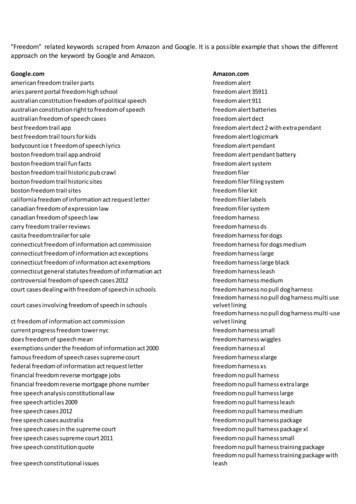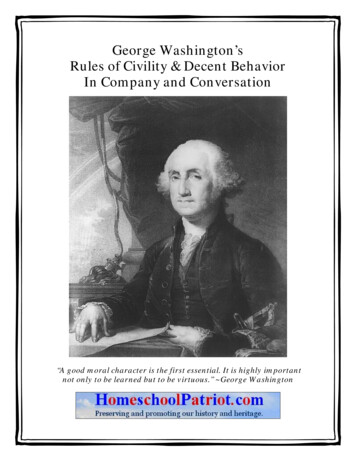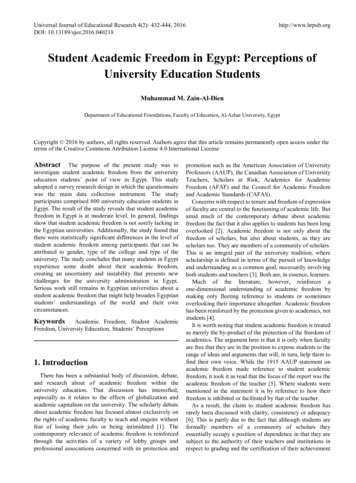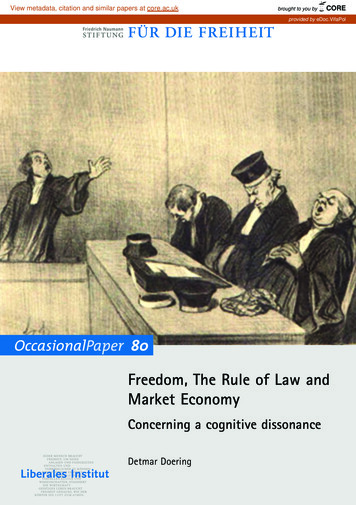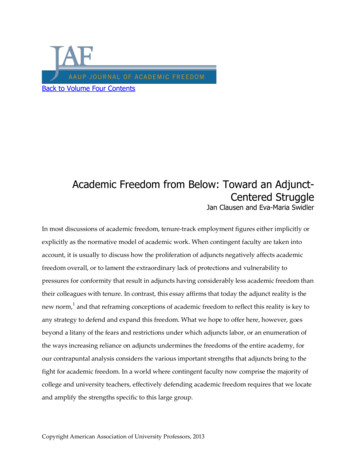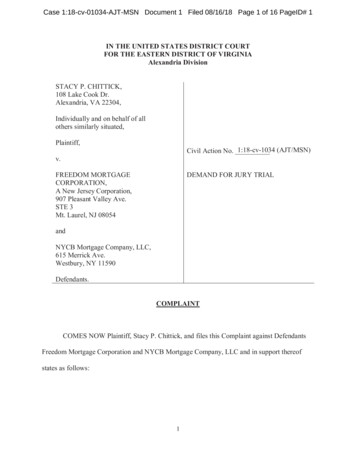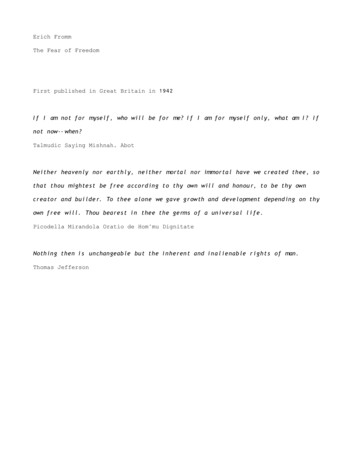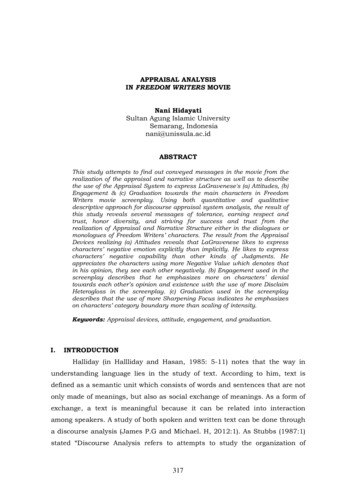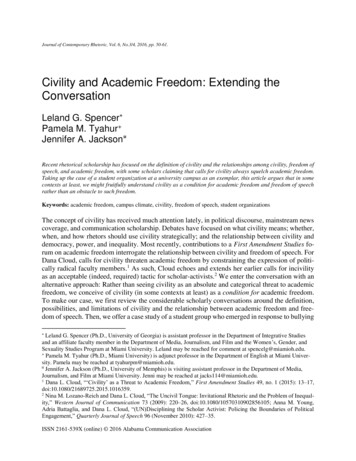
Transcription
Journal of Contemporary Rhetoric, Vol. 6, No.3/4, 2016, pp. 50-61.Civility and Academic Freedom: Extending theConversationLeland G. Spencer Pamela M. Tyahur Jennifer A. Jackson Recent rhetorical scholarship has focused on the definition of civility and the relationships among civility, freedom ofspeech, and academic freedom, with some scholars claiming that calls for civility always squelch academic freedom.Taking up the case of a student organization at a university campus as an exemplar, this article argues that in somecontexts at least, we might fruitfully understand civility as a condition for academic freedom and freedom of speechrather than an obstacle to such freedom.Keywords: academic freedom, campus climate, civility, freedom of speech, student organizationsThe concept of civility has received much attention lately, in political discourse, mainstream newscoverage, and communication scholarship. Debates have focused on what civility means; whether,when, and how rhetors should use civility strategically; and the relationship between civility anddemocracy, power, and inequality. Most recently, contributions to a First Amendment Studies forum on academic freedom interrogate the relationship between civility and freedom of speech. ForDana Cloud, calls for civility threaten academic freedom by constraining the expression of politically radical faculty members.1 As such, Cloud echoes and extends her earlier calls for incivilityas an acceptable (indeed, required) tactic for scholar-activists.2 We enter the conversation with analternative approach: Rather than seeing civility as an absolute and categorical threat to academicfreedom, we conceive of civility (in some contexts at least) as a condition for academic freedom.To make our case, we first review the considerable scholarly conversations around the definition,possibilities, and limitations of civility and the relationship between academic freedom and freedom of speech. Then, we offer a case study of a student group who emerged in response to bullying Leland G. Spencer (Ph.D., University of Georgia) is assistant professor in the Department of Integrative Studiesand an affiliate faculty member in the Department of Media, Journalism, and Film and the Women’s, Gender, andSexuality Studies Program at Miami University. Leland may be reached for comment at spencelg@miamioh.edu. Pamela M. Tyahur (Ph.D., Miami University) is adjunct professor in the Department of English at Miami University. Pamela may be reached at tyahurpm@miamioh.edu. Jennifer A. Jackson (Ph.D., University of Memphis) is visiting assistant professor in the Department of Media,Journalism, and Film at Miami University. Jenni may be reached at jacks114@miamioh.edu.1Dana L. Cloud, “‘Civility’ as a Threat to Academic Freedom,” First Amendment Studies 49, no. 1 (2015): 13–17,doi:10.1080/21689725.2015.1016359.2Nina M. Lozano-Reich and Dana L. Cloud, “The Uncivil Tongue: Invitational Rhetoric and the Problem of Inequality,” Western Journal of Communication 73 (2009): 220–26, doi:10.1080/10570310902856105; Anna M. Young,Adria Battaglia, and Dana L. Cloud, “(UN)Disciplining the Scholar Activist: Policing the Boundaries of PoliticalEngagement,” Quarterly Journal of Speech 96 (November 2010): 427–35.ISSN 2161-539X (online) 2016 Alabama Communication Association
Civility and Academic Freedom 51and harassment of minoritized students on our campus. In leading the campus community to embrace civility, the student group augmented the academic freedom of staff, faculty, and students(in essence, the university as a whole) whose expression and identities experienced the threat ofincivility. We conclude with a consideration of what our case study illustrates for the possibilitiesat the intersection of civility and freedom of expression.Defining and Complicating the Concept of CivilityThe work of defining the central terms or concepts in any project presents serious challenges. AsLeland Spencer has observed, coherence demands the definition of key terms, but “advanced studyin an area necessarily complicates the assumptions and terminology otherwise regarded as basicin the field.”3 Scholarly considerations of civility include a variety of definitions that, while resisting easy categorization, tend to reflect one of three themes, all of which principally treat civilityas a communicative strategy: Manners and politeness, awareness and acknowledgment, and robustparticipation in the democratic process.In everyday conversation, references to civility likely connote the shallowest conception of theterm: One that focuses on manners or politeness. P. M. Forni’s book on the subject offers advicelike avoiding idle complaints, listening, and refraining from loud cellphone conversations in public; while Forni’s front matter addresses more nuanced philosophical principles that underlie hisrules for considerate conduct, his book functionally stops at a conception of civility as politeness.4Treatments of civility that frame it as merely etiquette might be instructive for venues like selfhelp books and newspaper columns, but serious scholarly treatments of civility typically recognizethe importance of a more complex and layered understanding of civility.5The most common definitions of civility figure civility as an awareness, acknowledgment, andrespect for others. These understandings of civility center on the importance of human dignity,emphasizing the inherent worth of each person and the necessity of reflecting that worth in interactions, whether interpersonal or political.6 Stuckey and O’Rourke call this civility as politicalfriendship, where rhetors value respect (not merely tolerance) and approach communicative exchanges with charitably pure motives.7 Stephen Carter’s often-cited approach to civility soundssimilar. For Carter, civility is what we do “for the sake of our common journey with others, andLeland G. Spencer, “Introduction: Centering Transgender Studies and Gender Identity in Communication Scholarship,” in Transgender Communication Studies: Histories, Trends, and Trajectories, ed. Leland G. Spencer and JamieC. Capuzza (Lanham, MD: Lexington Books, 2015), x.4Pier Massimo Forni, Choosing Civility: The Twenty-Five Rules of Considerate Conduct (New York: St. Martin’sPress, 2002).5Mary E. Stuckey and Sean Patrick O’Rourke, “Civility, Democracy, and National Politics,” Rhetoric & Public Affairs 17, no. 4 (2014): 711–36; Craig Rood, “Rhetorics of Civility: Theory, Pedagogy, and Practice in Speaking andWriting Textbooks,” Rhetoric Review 32, no. 3 (2013): 331–48, doi:10.1080/07350198.2013.797879.6Sonja K. Foss and Cindy L. Griffin, “Beyond Persuasion: A Proposal for an Invitational Rhetoric,” CommunicationMonographs 62 (1995): 2–18; Jennifer Emerling Bone, Cindy L. Griffin, and T. M. Linda Scholz, “Beyond TraditionalConceptualizations of Rhetoric: Invitational Rhetoric and a Move toward Civility,” Western Journal of Communication 72 (2008): 434–62.7Stuckey and O’Rourke, “Civility, Democracy, and National Politics”; For an in-depth discussion that explores complications and contingencies related to the idea of political friendship, see Michael Leff, “Kind Persuasion: Lincoln’sTemperance Address and the Ethos of Civic Friendship,” in Making the Case: Advocacy and Judgment in PublicArgument, ed. Kathryn M. Olson et al. (East Lansing: Michigan State University Press, 2012), 75–94; see also, SusanZaeske, “Hearing the Silences in Lincoln’s Temperance Address: Whig Masculinity as an Ethic of Rhetorical Civility,” Rhetoric & Public Affairs 13, no. 3 (2010): 389–419.3
52 Spencer, Tyahur, & Jacksonout of love and respect for the very idea that there are others. When we are civil, we are not pretending to like those we actually despise; we are not pretending to hold any attitude toward them,except that we accept and value them as every bit our equals.”8 Alternatives on this same motifabound from understanding civility as a sacrifice we make for others, 9 to civility based on thepersonhood of others,10 to civility as a way to disagree without demonizing others,11 and to civilityas a strategy that keeps the conversation going.12Still other definitions of civility frame the concept as essential for and consubstantial withrobust democratic participation. Craig Rood, for instance, insists that “civility is more than just amatter of politeness or respecting the feelings of others [because] the very survival of our democracy is at stake.”13 With the same urgency as Rood, Stuckey and O’Rourke suggest that civilityought to mean creating an inclusive community that values incorporation rather than integration,which then welcomes a wide variety of rhetorical strategies including invective and humor. Civility must recognize rather than shy away from conflict; no adequate definition of civility wouldsquelch truth telling, exclude minority voices, or silence unpopular opinions. Stuckey andO’Rourke’s vision of civility acknowledges power difference, permits rather than constrains various forms of protest, and recognizes that interlocutors do not consistently share material or politicalinterests. Defending what many might consider uncivil communication, Stucky and O’Rourkesuggest that invective and vulgarity are the means of civility for oppressed people.14“Civility,” then, a condensation symbol extraordinaire,15 includes everything from rules foretiquette to modes of speech that purposely and performatively reject such rules. For our purposes,we embrace the second understanding of civility, one that focuses on respect and acknowledgmentof others, even while we aspire toward a broader vision for civility as one that includes whateverstrategies enable and enact healthy and robust democratic deliberation. Especially as we considerthe relationship between civility and free speech, we hesitate to go all the way with Stuckey andO’Rourke in celebrating invective. To the degree that freedom of speech does not shield speakersfrom taking responsibility for what they say, we find civility instructive. One way to begin unraveling this skein of complexity is to recognize civility as contextual, as many scholars do.16 Beforewe expand on the details of our own argument about civility, we first turn to the scholarly debateabout the value of (in)civility as a rhetorical strategy.8Stephen L. Carter, Civility: Manners, Morals, and the Etiquette of Democracy (New York: Basic Books, 1998), 35.Shelley D. Lane and Helen McCourt, “Uncivil Communication in Everyday Life: A Response to Benson’s ‘TheRhetoric of Civility,’” Journal of Contemporary Rhetoric 3, no. 1/2 (2013): 17–29.10Josina M. Makau and Debian L. Marty, Dialogue & Deliberation (Long Grove, IL: Waveland Press, 2013).11Leland G. Spencer, “Presiding Bishop Katharine Jefferts Schori and Possibilities for a Progressive Civility,” Southern Communication Journal 78, no. 5 (2013): 447–65, doi:10.1080/1041794X.2013.847480.12Ronald C. Arnett and Pat Arneson, Dialogic Civility in a Cynical Age: Community, Hope, and Interpersonal Relationships (Albany: State University of New York Press, 1999); Ronald C. Arnett, “Dialogic Civility as PragmaticEthical Praxis: An Interpersonal Metaphor for the Public Domain,” Communication Theory 11, no. 3 (2001): Rood, “Rhetorics of Civility,” 331.14Stuckey and O’Rourke, “Civility, Democracy, and National Politics.”15See David Zarefsky, “Presidential Rhetoric and the Power of Definition,” Presidential Studies Quarterly 34, no. 3(2004): 607–19, doi:10.1111/j.1741-5705.2004.00214.x.16Susan Herbst, Rude Democracy: Civility and Incivility in American Politics (Philadelphia, PA: Temple UniversityPress, 2010); Rood, “Rhetorics of Civility”; Thomas W. Benson, “The Rhetoric of Civility: Power, Authenticity, andDemocracy,” Journal of Contemporary Rhetoric 1, no. 1 (2011): 22–30; Christopher R. Darr, “Civility as RhetoricalEnactment: The John Ashcroft ‘Debates’ and Burke’s Theory of Form,” Southern Communication Journal 70 (2005):316–28; Christopher R. Darr, “Civility and Social Responsibility: ‘Civil Rationality’ in the Confirmation Hearings ofJustices Roberts and Alito,” Argumentation & Advocacy 44, no. 2 (2007): 57–74.9
Civility and Academic Freedom 53Civility, Strategy, and Social ChangeIn 2008, Jennifer Bone, Cindy Griffin, and Linda Scholz extended the theory of invitational rhetoric in their call for civility, concluding: “When we speak from a place of invitation, of civility,we cannot pretend that we journey alone, that others are unworthy or without voice, or that ourview is the only ‘right’’ view.”17 In a rejoinder, Nina Lozano-Reich and Dana Cloud charged Boneand colleagues with wielding invitation and civility as “bludgeons of the oppressor”18 that silencedissent and other, more radical forms of activism. Elsewhere, Cloud and colleagues have claimedthat calls for civility ignore material antagonisms.19 As Spencer has summarized Lozano-Reichand Cloud’s perspective, in this view, “only combativeness constitutes a fitting rhetorical responseto conflicts because conflict always emerges from and signifies relationships of oppressive inequality [.] when one understands confrontation as necessary, civility is relegated to a conservativetrope that buttresses the (always oppressive) status quo.”20Responses to the debate have acknowledged the critique levied by Cloud and colleagues asvaluable but also limited. Rood agrees that civility can sometimes serve the interests of those withmore power but does not see such a constraint as a reason to normalize incivility instead.21 Ideally,Rood contends, civility allows for emotive speech, dissent, and a multitude of voices as civilityfunctions to “slow down and focus arguments, thereby creating time and space to explore differences and disagreements in ways that help all involved commit to understanding and being understood, respecting and being respected.”22 In another example of civility’s positive and progressivepotential, John Durham Peters praises the sit-in movement not for rejecting civility, but for exaggerating it: “The conviction of the other’s conscience comes from a civility taken to its extreme.With a mockery so infinitesimal that no one could ever detect it for sure, four young men inGreensboro, North Carolina, in 1960 kept asking for “a cup of coffee, please” at the whites-onlylunch counter in Woolworth’s.”23 In a similar vein, Spencer’s analysis of Episcopal PresidingBishop Katharine Jefferts Schori concludes that civility has progressive potential. Because JeffertsSchori engages civilly with people who agree and disagree with her position about human sexualityin the church, she manages to transcend such controversies and helps all of her constituents concentrate on her vision for a church that acts as a force for social justice in the world.24Bone, Griffin, and Scholz, “Beyond Traditional Conceptualizations,” 457.Lozano-Reich and Cloud, “Uncivil Tongue,” 225.19Young, Battaglia, and Cloud, “(UN)Disciplining.”20Spencer, “Presiding Bishop,” 451–452; see also, Sonja K. Foss and Karen A. Foss, “Constricted and ConstructedPotentiality: An Inquiry Into Paradigms of Change,” Western Journal of Communication 75, no. 2 (2011): 205–38,doi:10.1080/10570314.2011.553878.21Rood, “Rhetorics of Civility.”22Craig Rood, “‘Moves’ toward Rhetorical Civility,” Pedagogy: Critical Approaches to Teaching Literature Language Composition and Culture 14, no. 3 (2014): 410, doi:10.1215/15314200-2715778.23John Durham Peters, Courting the Abyss: Free Speech and the Liberal Tradition (Chicago: University of ChicagoPress, 2005), 271–272.24Spencer, “Presiding Bishop”; For additional examples that celebrate the utility of civility in a variety of contexts,see Bone, Griffin, and Scholz, “Beyond Traditional Conceptualizations”; Leland G. Spencer, “Engaging Undergraduates in Feminist Classrooms: An Exploration of Professors’ Practices,” Equity & Excellence in Education 48, no. 2(2015): 195–211, doi:10.1080/10665684.2015.1022909; Craig Rood, “Barack Obama, ‘University of Notre DameCommencement’ (17 May 2009),” Voices of Democracy 7 (2012): 60–75; Craig Rood, “‘Understanding’ Again: Listening with Kenneth Burke and Wayne Booth,” Rhetoric Society Quarterly 44, no. 5 (2014): 449–69,doi:10.1080/02773945.2014.965337.1718
54 Spencer, Tyahur, & JacksonWhile Rood, Spencer, and others have resisted the push for incivility, other scholars have identified positive case studies of incivility. In our view, these examples actually illustrate some limitations of the confrontationalist critique and underscore the enduring importance of civility, particularly when confrontation and civility get counterposed as opposite and categorical choices. Forinstance, Jeffrey Kurtz’s rhetorical criticism of Congressman Joe Wilson, who (in)famouslyyelled, “You lie!” during a speech delivered by President Obama, celebrated that “In shouting‘You lie!,’ Wilson made the case for the authentic and outrageous in political discourse, and theways in which authenticity and outrageousness may be used to unsettle political convention.”25Unfortunately, Kurtz’s essay lacks a systematic reflection on the racial politics and privilege inherent in the outburst. New York Times columnist Maureen Dowd picked up on the subtext Kurtzmissed:The congressman, we learned, belonged to the Sons of Confederate Veterans, led a 2000 campaignto keep the Confederate flag waving above South Carolina’s state Capitol and denounced as a“smear” the true claim of a black woman that she was the daughter of Strom Thurmond, the ’48segregationist candidate for president. Wilson clearly did not like being lectured and even rebukedby the brainy black president presiding over the majestic chamber.26Only a colorblind reading of Wilson’s speech can celebrate his incivility without recognizing thatin this case, incivility becomes the bludgeon, a tool of racist oppression in a vast network of whitesupremacist strategies for delegitimizing Obama’s presidency.27Susan Herbst’s analysis of the 2008 presidential campaign likewise celebrates Sarah Palin asa successful example of incivility. Palin refers to Obama as a terrorist, a socialist, and as un-American. Palin then offers a defense of her incivility. In Herbst’s words, “Palin does not simply criticizebut justifies doing so, sometimes as preface to remarks and sometimes immediately following anattack,” such as when Palin says, “It’s not mean-spirited.to call someone out on their record, theirplans, their associations.”28 Herbst, too, remains breathtakingly silent on the white supremacistlogics that underlie Palin’s incivility.29 These examples reveal the dubiousness of any dichotomybetween civility/oppression and incivility/activism. Rather than seeing civility and incivility onlyas a categorical binary, we submit that in some circumstances, civility constitutes not only a fittingrhetorical response, but also one that paves the way for more free expression.Civility, Free Speech, and Academic FreedomThe claim that calls civility a threat to academic freedom resulted specifically from the case ofSteven Salaita, whose academic job offer the University of Illinois rescinded because of messagesSalaita posted on Twitter about conflicts in the Middle East. The university’s provost, accordingto Cloud, “invoked the norm of civility as a warrant” for retracting the employment offer and thusJeffrey B. Kurtz, “Civility, American Style,” Relevant Rhetoric 3 (2012): 8.Maureen Dowd, “Boy, Oh, Boy,” The New York Times, September 13, 2009, WK17.27For more on the problem of colorblind racism, see Charles A. Gallagher, “Color-Blind Privilege: The Social andPolitical Functions of Erasing the Color Line in Post Race America,” Race, Gender & Class 10, no. 4 (2003): 22–37.28Herbst, Rude Democracy, 56–57.29For more nuanced analyses of Palin’s (un)civil discourse and its relationship to free speech, see Beth L. Boser andRandall A. Lake, “‘Enduring’ Incivility: Sarah Palin and the Tucson Tragedy,” Rhetoric & Public Affairs 17, no. 4(2014): 619–51; Brett Lunceford, “On the Rhetoric of Second Amendment Remedies,” Journal of ContemporaryRhetoric 1, no. 1 (2011): 31–39.2526
Civility and Academic Freedom 55violated standards of academic freedom.30 We acknowledge that in this case, the university attempted to hide its effort to silence Salaita behind the veneer of a call for civility; our argumentsuggests that civility ought and need not always function as it did in this case, but can insteadcontribute to a freer and more expressive climate for all persons. In this section, we consider therelationship between academic freedom and freedom of speech.Academic freedom and freedom of speech share an indirect link. The First Amendment guarantees rights granted to the individuals in the United States to prevent the government from overstepping, but with certain limitations. Even the Constitution of the Commonwealth of Pennsylvania understood this to be true as far back as 1790. As it states: “The free communication of thoughtsand opinions is one of the invaluable rights of man; and every citizen may freely speak, write andprint on any subject, being responsible for the abuse of that liberty.”31 These limitations are basedon civility and the desire to maintain a civil society. Benson explains, “Our shared concern withcivility as a communicative practice also carries with it an implicit sense that talk has consequencesand that uncivil speech is not merely rude but that it has effects.”32 Describing such effects, RobertO’Neil underscored the difficult but necessary tension between fostering diversity and inclusiveness on university campuses and encouraging free expression. O’Neil concluded that “reachingthe right balance is the inescapable goal” for campuses.33According to the First Amendment Center, “the courts allow school officials to regulate certaintypes of expression. For example, school officials may prohibit speech that substantially disruptsthe school environment or that invades the rights of others.”34 This is a reason to consider civilityas a condition for academic freedom and not always an obstacle. The courts have recognized thatacademic freedom applies not only to faculty, but also to universities as a whole due to the university’s responsibility to the entire campus population. The university has a responsibility and interest in creating an environment that ensures freedom of expression for all students, faculty, andstaff. In the most often cited Supreme Court case about this, Sweezy v. New Hampshire (1957),both the majority opinion and concurring opinions recognized the “essentiality of freedom in thecommunity of American universities.”35 In this case, the court made clear that the universitiesshould be independent of governing bodies (Church or State),36 but also provides the additionalprotections of the university based on academic freedom: “It is the business of a university toprovide that atmosphere which is most conducive to speculation, experimentation, and creation. Itis an atmosphere in which there prevail the four essential freedoms of the university - to determinefor itself on academic grounds who may teach, what may be taught, how it shall be taught, andwho may be admitted to study.”37 We suggest that calls for civility can assist rather than alwaysimpede such a goal.Cloud, “‘Civility’ as a Threat,” 15.David J. Bodenhamer, Our Rights (Oxford University Press, 2007), 65.32Benson, “Rhetoric of Civility,” 23.33Robert M. O’Neil, “An Inquiry into the Legal and Ethical Problems of Campus Hate Speech,” Free Speech Yearbook29, no. 1 (1991): 30, doi:10.1080/08997225.1991.10556129.34First Amendment Center, “What Rights to Freedom of Expression Do Students Have?,” May 22, ezy v. New Hampshire 354 US 234 (1957).36Sweezy v. New Hampshire 354 US 234 (1957), 262-263; Robert Margesson, “A Special Kind of ‘Right’: The Supreme Court’s Affirmation of Academic Freedom,” First Amendment Studies 49, no. 2 (2015): 92,doi:10.1080/21689725.2015.1078183.37Ibid.3031
56 Spencer, Tyahur, & JacksonCase Study: Civility and Free Expression on CampusOur argument that civility can function as a condition for freedom of expression on campus—forstudents and faculty—draws on the success of a student group on our small, regional campus inthe Midwest. The student group, Project Civility, emerged in response to incivility on campus andhosts a number of events that simultaneously encourage civil behavior (capaciously defined), democratic participation, freedom of expression, and civic responsibility. The range of events and programs the group sponsors covers the full spectrum of civility as defined by the rhetorical scholarscited earlier.Students on our campus formed Project Civility in 2011 in response to homophobic bullyingand other rude comments directed at students on campus earlier in the academic year. The initiativebegan when the student government organization discussed the incident of incivility on campus.Officers initially wanted to pursue a punitive response for the offending students based on theuniversity’s code of conduct, but after discussion the group decided instead to launch Project Civility in an effort to foster a greater sense of civility, broadly defined, on campus. While the groupbegan with activities that drew on a narrow notion of civility as politeness, it eventually progressedto events and programs that invoked richer resources available under the large conceptual tent ofcivility.Civility as Politeness: Wooden Nickels and Social MediaOne of Project Civility’s first projects involved the printing of wooden nickels with the group’slogo on them. Members of the organization carry a supply of wooden nickels and distribute themwhen they espy an act of civility. For example, members of the group have awarded wooden nickels to people who hold doors open for others, to members of the campus community who go outof their way to help strangers, and to a student who picked up litter in a campus parking lot. Onemember of Project Civility awarded a nickel to a staff member who helped to organize a naturalization ceremony on campus, especially because the staff member worked extra hours and wentbeyond the normal call of duty to make the event a success, but also because the group recognizedthe value of the event itself; the naturalization ceremony, held on Constitution Day, celebrates andextends citizenship.In order to share the message of civility more broadly, group members who award civilitynickels typically pose for a photograph with the awardee then upload it to the group’s social mediaaccount. In addition to raising awareness about the existence of the campus group, the social mediaaccount reminds staff, students, and faculty as well as community members and followers frombeyond the university about the importance of civility in social life. The group understands thesocial media page as a way to inspire future acts of civility among its audiences. In a world wheremany bemoan a lack of civility,38 the wooden nickels and their (mediated) dissemination stand asa testimony to civility’s power and perseverance. Although the wooden nickels represent the simplest form of civility, the group remains committed to recognizing and thanking people for theircivil behaviors.We view the relationship between civility nickels and freedom of expression as indirect butvaluable. In a literal and denotative sense, the distribution of civility nickels obviously does nothing to constrain expression, but it does encourage certain kinds of expression. Particularly becauseJack Leslie et al., “Civility in America, 2014” (Weber Shandwick and Powel Tate, 2014), ivility-in-america-2014.pdf.38
Civility and Academic Freedom 57Project Civility created wooden nickels as a response to behaviors and the impression of a campusclimate that limited expression, especially queer and trans students’ ability to express their identities, we contend that the wooden nickels and the overall project of increasing politeness on campusenables more (and more diverse) expression. Even while we celebrate this work, we agree withStuckey and O’Rourke’s assessment about the status of politeness as one of the shallowest definitions of civility.39 Fortunately, Project Civility has expanded beyond wooden nickels to engage thecampus more deeply in thinking about civility and living civilly.Civility as Political Friendship & Democratic Participation: Guest Speakers, Community ActivismProject Civility has a more charitable view than Stuckey and O’Rourke of civility as politeness,but the group does not stop there. They also host programs that invite the campus to understandcivility at a deeper level of intellectual and civic engagement. Because Project Civility emerged inresponse to bullying and harassment of minoritized students on campus, Project Civility intentionally created programming that addressed social justice and countering systemic oppression. Thegroup brought a speaker to campus who grew up in Nazi Germany. The speaker explained howshe and a close friend, as members of the Hitler Youth, eventually realized that the songs they hadbeen taught to sing were more than merely patriotic: Indeed, these songs forwarded the agenda ofthe Nazi regime. Living in a country where people faced severe punishment for criticism of thegovernment taught this speaker the importance of a civility that goes beyond politeness to politicalengagement, then on to active involvement in the world in a way that reduces the suffering ofothers. Notably, this speaker’s definition of civility, one that she invited Project Civility to embracefor its own work, recognizes civility as necessary for the resistance of oppression. True civilitymeans sometimes rejecting messages from the government or others
help books and newspaper columns, but serious scholarly treatments of civility typically recognize . see Michael Leff, "Kind Persuasion: Lincoln's Temperance Address and the Ethos of Civic Friendship," in Making the Case: Advocacy and Judgment in Public . Craig Rood, for instance, insists that "civility is more than just a
